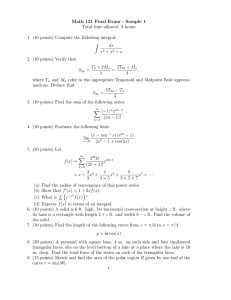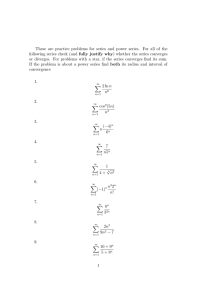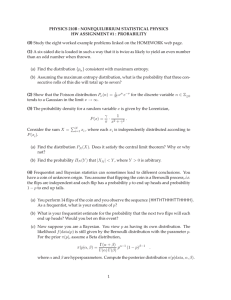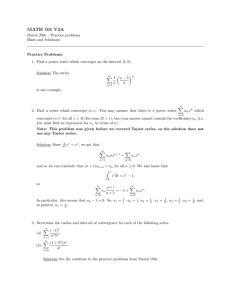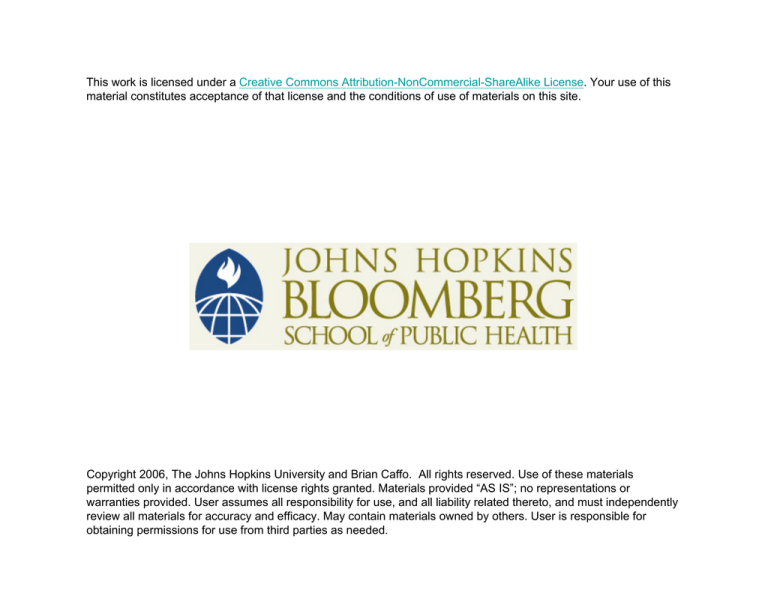
This work is licensed under a Creative Commons Attribution-NonCommercial-ShareAlike License. Your use of this
material constitutes acceptance of that license and the conditions of use of materials on this site.
Copyright 2006, The Johns Hopkins University and Brian Caffo. All rights reserved. Use of these materials
permitted only in accordance with license rights granted. Materials provided “AS IS”; no representations or
warranties provided. User assumes all responsibility for use, and all liability related thereto, and must independently
review all materials for accuracy and efficacy. May contain materials owned by others. User is responsible for
obtaining permissions for use from third parties as needed.
Outline
1. Define convergent series
2. Definte the Law of Large Numbers
3. Define the Central Limit Theorem
4. Create Wald confidence intervals using the CLT
Numerical limits
• Imagine
a sequence
a1 = .9,
a2 = .99,
a3 = .999, . . .
• Clearly
this sequence converges to 1
• Definition
of a limit: For any fixed distance we can
find a point in the sequence so that the sequence is
closer to the limit than that distance from that point
on
• |an − 1| = 10−n
Limits of random variables
• The
problem is harder for random variables
• Consider X̄n
the sample average of the first n of a collection of iid observations
Example X̄n could be the average of the result of n
coin flips (i.e. the sample proportion of heads)
say that X̄n converges in probability to a limit
if for any fixed distance the probability of X̄n being
closer (further away) than that distance from the limit
converges to one (zero)
• We
• P (|X̄n − limit| < ǫ) → 1
The Law of Large Numbers
• Establishing
that a random sequence converges to a
limit is hard
• Fortunately, we have a theorem that does all the work
for us, called the Law of Large Numbers
• The
law of large numbers states that if X1, . . . Xn are
iid from a population with mean µ and variance σ2
then X̄n converges in probability to µ
• (There
are many variations on the LLN; we are using
a particularly lazy one)
Proof using Chebyshev’s inequality
• Recall
Chebyshev’s inequality states that the probability that a random variable variable is more than k
standard deviations from its mean is less than 1/k2
• Therefore
for the sample mean
P |X̄n − µ| ≥ k
• Pick
sd(X̄n) ≤ 1/k2
a distance ǫ and let k = ǫ/sd(X̄n)
sd(X̄n)2
P (|X̄n − µ| ≥ ǫ) ≤
ǫ2
σ2
= 2
nǫ
0
20
40
60
iteration
80
100
−0.6
−0.2 0.0
average
0.2
Useful facts
• Functions
of convergent random sequences converge
to to the function evaluated at the limit
• This
includes sums, products, differences, ...
• Example (X̄n)2
• Notice
converges to µ2
that this is different than (
verges to E[Xi2] = σ2 + µ2
• We
P
Xi2)/n
which con-
can use this to prove that the sample variance
converges to σ2
Continued
X
2
2
X
n(
X̄
)
n
i −
(Xi − X̄n)2/(n − 1) =
n−1
n−1
P 2
Xi
n
n
=
×
−
× (X̄n)2
n−1
n
n−1
P
p
→ 1 × (σ 2 + µ2) − 1 × µ2
= σ2
Hence we also know that the sample standard deviation
converges to σ
Discussion
• An estimator is consistent if it converges to what you
want to estimate
• The
LLN basically states that the sample mean is consistent
• We just showed that the sample variance and the sam-
ple standard deviation are consistent as well
• Recall also that the sample mean and the sample vari-
ance are unbiased as well
• (The
sample standard deviation is not unbiased, by
the way)
The Central Limit Theorem
Central Limit Theorem (CLT) is one of the most
important theorems in statistics
• The
• For
our purposes, the CLT states that the distribution
of averages of iid variables, properly normalized, becomes that of a standard normal as the sample size
increases
• The
CLT applies in an endless variety of settings
The CLT
• Let X1, . . . , Xn
be a collection of iid random variables
with mean µ and variance σ2
• Let X̄n
• Then
• Notice
be their sample average
P
X̄n − µ
√ ≤z
σ/ n
→ Φ(z)
the form of the normalized quantity
X̄n − µ Estimate − Mean of estimate
√ =
.
σ/ n
Std. Err. of estimate
Example
• Simulate a standard normal random variable by rolling
n
(six sided)
• Let Xi
• Then
be the outcome for die i
note that µ = E[Xi] = 3.5
• Var(Xi) = 17.5/6
p
√
• SE 17.5/6n = 4.1833/ 6n
• Standardized
• Notice
mean
X̄n − 3.5
√
4.1833/ 6n
that when n = 6 this formula simplifies to
P6
i=1 Xi − 21
4.1833
−3
−1
1
2
3
0.2
0.0
0.2
0.0
0.0
0.2
0.4
6 die rolls
0.4
2 die rolls
0.4
1 die rolls
−3
−1
1
2
3
−3
−1
1
2
3
Coin CLT
be the 0 or 1 result of the ith flip of a possibly
unfair coin
• Let Xi
• The
sample proportion, say p̂, is the average of the
coin flips
• E[Xi] = p
and Var(Xi) = p(1 − p)
• Standard
• Then
error of the mean is
√
p(1 − p)/ n
p̂ − p
p
p(1 − p)/n
will be approximately normally distributed
1
2
3
0.4
0.0
−3
1
2
3
−3
−1
1
2
3
1
2
3
0.4
density
0.0
0.0
0.2
density
0.2
0.0
−3
−1
20 coin flips
0.4
10 coin flips
0.4
1 coin flips
−1
0.2
−1
0.2
density
0.0
0.2
density
0.2
0.0
density
−3
density
20 coin flips
0.4
10 coin flips
0.4
1 coin flips
−3
−1
1
2
3
−3
−1
1
2
3
CLT in practice
• In
practice the CLT is mostly useful as an approximation
P
X̄n − µ
√ ≤z
σ/ n
≈ Φ(z).
is a good approximation to the .975th quantile of the standard normal
• Recall 1.96
• Consider
.95 ≈ P
X̄n − µ
√ ≤ 1.96
−1.96 ≤
σ/ n
√ √
= P X̄n + 1.96σ/ n ≥ µ ≤ X̄n − 1.96σ/ n ,
Confidence intervals
• Therefore,
according to the CLT, the probaiblity that
the random interval
√
X̄n ± z1−α/2σ/ n
contains µ is approximately 95%, where z1−α/2 is the
1 − α/2 quantile of the standard normal distribution
• This
is called a 95% confidence interval for µ
• Slutsky’s theorem, allows us to replace the unknown
σ
with s
Sample proportions
• In the event that each Xi is 0 or 1 with common success
probability p then σ = p(1 − p)
• The
interval takes the formr
p̂ ± z1−α/2
p(1 − p)
n
• Replacing p
by p̂ in the standard error results in what
is called a Wald confidence interval for p
• Also
note that p(1 − p) ≤ 1/4 for 0 ≤ p ≤ 1
• Let α = .05
so that z1−α/2 = 1.96 ≈ 2 then
r
2
• Therefore p̂ ± √1n
r
p(1 − p)
≤2
n
1
1
=√
4n
n
is a quick CI estimate for p


